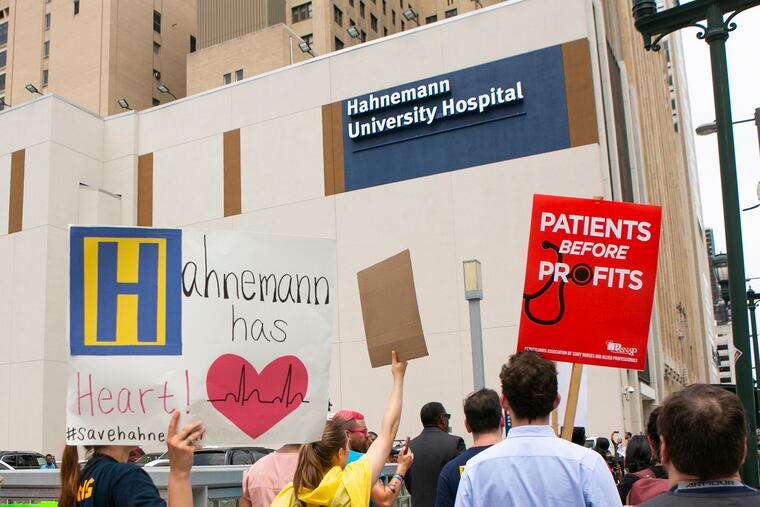As Hahnemann’s patient count dwindles to single digits, Temple and Jefferson see uptick in patients
Temple says many of the people who would have sought care at Hahnemann are turning up a few blocks away at Temple. That's going to be expensive.

Hahnemann University Hospital remains open, but as the cash-strapped hospital moves toward a planned September closure and the daily census dips toward single digits, nearby medical centers are seeing an uptick in patients.
Temple University Hospital, three miles up Broad Street, has treated an additional 35 patients a day in its emergency department since Hahnemann stopped accepting critical care and trauma patients in July. Demand for Temple’s obstetrics and psychiatric care are also on the rise since Hahnemann filed for Chapter 11 bankruptcy in late June and began winding down services, including its maternity ward.
Thomas Jefferson University Hospital has seen an uptick in its maternity unit, doctor’s offices, and emergency department, where an additional 25 to 35 patients a day are showing up.
Philadelphia hospital administrators have said they have the capacity to accommodate Hahnemann’s patients and are prepared for the influx. But a majority of the hospital’s patients come from some of the city’s poorest, sickest neighborhoods, which poses a challenge for the closest, most easily accessible hospitals that will likely take a large share of Hahnemann’s patients.
“While we are planning for the additional volume that will come, we recognize that we have limited capacity due to our aging infrastructure and limited ability to invest in new equipment,” Marc Hurowitz, CEO of Temple Physicians, said at a public hearing of the House Democratic Policy Committee, held Monday in the Fox Chase neighborhood.
Where Philadelphia Hospitals Get Their Patients
Hahnemann University Hospital was the top pick for inpatient admissions in four of Philadelphia's 48 zip codes, and ranks sixth citywide among the nine hospitals with comprehensive emergency-room services.

Pennsylvania’s Department of Health assigned a temporary manager to oversee an orderly, unit-by-unit wind-down of Hahnemann’s services. While the emergency department remains open to patients who can be treated and released, the hospital stopped admitting patients through the emergency department on July 17. The hospital’s maternity ward, where about 1,780 babies were delivered in 2017, shut down July 9.
The move has led to a precipitous drop in patients at Hahnemann, since the vast majority of hospital admissions came through the ED. On Monday, the 496-bed hospital had just a dozen patients, though the patient count continues to fluctuate daily, a spokesperson for the Pennsylvania Department of Health said.
Even with few patients to treat, the state has not yet said when Hahnemann may cease operations entirely.
“While services are winding down at Hahnemann, the closure plan has not yet been accepted by DOH or the Philadelphia Health Department. Our temporary manager remains on site to ensure that patients … continue to receive quality care and that supply needs are being met by the hospital owners,” April Hutcheson, a spokesperson for the state Health Department, said in an email.
Hahnemann had 17,000 hospital admissions and 53,000 emergency department visits — or about 150 a day — in 2017, according to state data.
Thomas Jefferson University Hospital and Pennsylvania Hospital, both within 1.5 miles of Hahnemann, are expected to absorb many of those patients. While it did not give specifics, Pennsylvania Hospital saw a rise in emergency department and obstetrics visits, as well as inquiries from women seeking to transfer their obstetrics care to Penn Medicine doctors, said Patrick Norton, a vice president of public affairs.
Jefferson, which had about 320 emergency department visits a day in 2017, has increased staffing to handle additional patients. The hospital has also formed a task force to monitor increases in demand, Gianna DeMedio, a spokesperson for Jefferson, said in an email.
The 35 additional daily emergency room patients at Temple represents a 15% increase from its average of 231 patients a day in fiscal 2018, according to Temple spokesperson Jeremy Walter. A majority of the extra emergency room patients are walk-ins, with about seven a day arriving by ambulance.
Labor and deliveries in the maternity ward are up 12%, he said.
In his remarks Monday, Hurowitz said he is confident that Temple and the city’s other hospitals will be able to respond to patients’ needs. But he implored lawmakers to “not expect us to operate below the safety line,” which he later said meant ensuring that the hospital was able to meet patient demand without compromising quality or safety.
State Rep. Kevin Boyle, a Democrat who represents Philadelphia and Montgomery Counties and called for the hearing Monday, said the state must do more to financially support the hospitals absorbing Hahnemann’s patients and to prevent more closures.
“There is certainly a trend to close hospitals that disproportionately serve people who are lower-income citizens … something needs to be done about it as soon as possible,” Boyle said in an interview Tuesday.
Philadelphia Health Commissioner Thomas Farley and city leaders are meeting regularly with the hospitals affected by Hahnemann’s closure, said James Garrow, a spokesperson for the city Health Department.
“While the city doesn’t have regulatory oversight of any hospital, nor can we compel any hospital to change their practices, we are working with each of the other hospitals together to make sure that every patient who is affected by the Hahnemann closure has a place to get care in the most frictionless way. As in everything, the devil is in the details, but we’re happy that the hospital community in Philadelphia has come together and is working to make sure that everyone is taken care of,” Garrow said in an email.